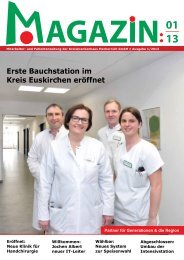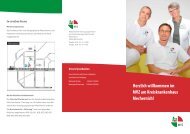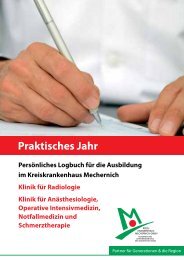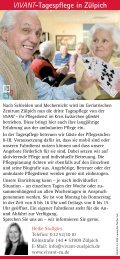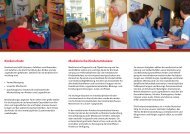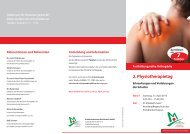scapula fracture classification system - Kreiskrankenhaus Mechernich
scapula fracture classification system - Kreiskrankenhaus Mechernich
scapula fracture classification system - Kreiskrankenhaus Mechernich
Create successful ePaper yourself
Turn your PDF publications into a flip-book with our unique Google optimized e-Paper software.
518 M. Jaeger et al.<br />
Figure 7<br />
Fracture of the articular segment not involving the glenoid fossa (F0). Ó 2012, Jaeger et al.<br />
Table I Coding agreement and reliability for glenoid fossa <strong>fracture</strong>s according to focused <strong>system</strong><br />
Fracture subsets Categories) No. of cases y Full agreement k Coefficient<br />
Overall Pair-wise (21 pairs)<br />
Minimum Median Maximum<br />
Simple fossa (F1) 50% 0.66 0.35 0.67 0.82<br />
1 14 0.70<br />
2 7 0.65<br />
3 17 0.62<br />
Multifragmentary fossa (F2) 4/5 7/0 100%<br />
F1(1) and F1(2) combined a/b/c 4/9/8 24% 0.46 0.07 0.53 0.89<br />
F1(3) a/b/c 3/8/6 29% 0.39 0.03 0.36 0.88<br />
) The categories of 1 to 5 represent the following: 1, anterior simple rim or oblique <strong>fracture</strong>; 2, posterior simple rim or oblique <strong>fracture</strong>; 3, simple<br />
transverse or short oblique <strong>fracture</strong>; 4, multifragmentary fossa with more than 2 <strong>fracture</strong> line exit points; and 5, multifragmentary fossa with central<br />
<strong>fracture</strong>-dislocation (no exit line through the rim).<br />
y Estimated by latent class analysis and the distribution of the surgeons’ codes.<br />
detailed sub<strong>classification</strong> seems to be reproducible with<br />
high accuracy (>80%) in all categories of F1 (1, 2, and 3).<br />
A more detailed description of rim <strong>fracture</strong>s with respect to<br />
their location to the equator becomes less reliable and is<br />
most pronounced when differentiating short oblique <strong>fracture</strong>s<br />
[F1(3)]. This cannot be done without a CT scan and<br />
was still not highly reliable with 3D volume rendering. One<br />
reason for this outcome might be the method used in this<br />
study. To provide the same data for all participating<br />
surgeons, 1 shoulder surgeon performed the volume<br />
rendering of all CT scans. The result was presented to the<br />
surgeons as a movie sequence in a 360 horizontal and 360 <br />
vertical rotation; this setting was chosen based on common<br />
practice (usually of the radiologist) in presenting these<br />
types of data for further evaluation. Subsequently, the other<br />
shoulder surgeons did not perform their own 3D analysis,<br />
that is, they were unable to rotate or focus the 3D scans<br />
according to their own needs, and as such, their accuracy<br />
may have been limited. On the other hand, these results<br />
highlight the difficulty in distinguishing <strong>fracture</strong>s bordering<br />
between 2 categories. Because the distribution of all glenoid<br />
<strong>fracture</strong>s can be considered a continuum of possible<br />
patterns, any category is inherently associated with some<br />
level of imprecision for adjacent <strong>fracture</strong> pathologies.<br />
Former <strong>scapula</strong> <strong>classification</strong>s, especially of the glenoid,<br />
were conducted based on the assessment of plain radiographs.<br />
5,15,24 All of them were published without further<br />
reliability assessment. To our knowledge, this is the first<br />
study providing an evaluation of <strong>classification</strong> reliability<br />
and accuracy. Armitage et al 3 recently provided a frequency<br />
map of surgically treated <strong>scapula</strong> <strong>fracture</strong>s. To our knowledge,<br />
this was the first article until now describing the use<br />
of 3D CT volume rendering to enhance the mapping of<br />
<strong>scapula</strong> <strong>fracture</strong>s. In contrast to our study, Armitage et al



